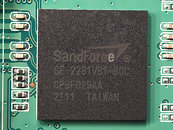- Joined
- Oct 9, 2007
- Messages
- 46,349 (7.68/day)
- Location
- Hyderabad, India
| System Name | RBMK-1000 |
|---|---|
| Processor | AMD Ryzen 7 5700G |
| Motherboard | ASUS ROG Strix B450-E Gaming |
| Cooling | DeepCool Gammax L240 V2 |
| Memory | 2x 8GB G.Skill Sniper X |
| Video Card(s) | Palit GeForce RTX 2080 SUPER GameRock |
| Storage | Western Digital Black NVMe 512GB |
| Display(s) | BenQ 1440p 60 Hz 27-inch |
| Case | Corsair Carbide 100R |
| Audio Device(s) | ASUS SupremeFX S1220A |
| Power Supply | Cooler Master MWE Gold 650W |
| Mouse | ASUS ROG Strix Impact |
| Keyboard | Gamdias Hermes E2 |
| Software | Windows 11 Pro |
To anyone who's familiar with SSDs, "SandForce" is equally familiar, as it makes the brains of some of the fastest client SSDs in the business. Buyers have also come to know of SandForce-driven SSDs as being characterized by unique capacity amounts caused by allocating a certain amount of the physical NAND flash capacity for some special low-level tasks by the controller, resulting in capacities such as 60 GB, 120 GB, 240 GB, for drives with physical NAND flash capacities of 64, 128, and 256 GB, respectively. This allocation is called "over-provisioning". An impression was built that this ~7% loss in capacity is some sort of a trade-off for higher performance. It appears like that's not quite the case.

SandForce released a code to SSD manufacturers, which causes the drives to operate without that ~7% over-provisioning, providing nearly 100% of the physically-available NAND flash as unformatted capacity to the end-user, without loss in performance. All modern SSDs need a certain amount of their physical NAND flash allocated by the controller to map out bad-blocks, and data marked for deletion when the OS issues a TRIM command to delete something, which the controller later leisurely ruminates upon like a cow (ensuring users don't experience drops in performance caused by NAND flash write cycles).
What SandForce achieved with its newest code is let SSD manufacturers use what's called "0% over-provisioning". This is impossible in the real-world, but can be achieved handing over the difference in capacity between "billions of bytes" and "gigabytes" towards user area. This delta is really 7.37% of the physical capacity. The real difference in user capacity between a 120 GB its 128 GB physical NAND flash capacity really is 7% + 7.37%, or 14.37%. The translation of Billion bytes and gigabytes was made by HDD manufacturers a while ago, so most users don't notice that difference. What the new firmware for the SF-2000 processor family now permits, is for manufacturers to create SSDs at full binary capacity points with what is commonly known as "0% over-provisioning".
In other words, buyers will soon see SandForce-driven SSDs with capacities such as 64 GB, 128 GB, 256 GB, etc., with ~7% higher user-space, and no loss in performance. This is not to be confused with some SandForce-driven SSDs launched in the past, bearing labels of canonical capacities (64, 128, 256 GB), denoting physical NAND flash capacity.
View at TechPowerUp Main Site

SandForce released a code to SSD manufacturers, which causes the drives to operate without that ~7% over-provisioning, providing nearly 100% of the physically-available NAND flash as unformatted capacity to the end-user, without loss in performance. All modern SSDs need a certain amount of their physical NAND flash allocated by the controller to map out bad-blocks, and data marked for deletion when the OS issues a TRIM command to delete something, which the controller later leisurely ruminates upon like a cow (ensuring users don't experience drops in performance caused by NAND flash write cycles).
What SandForce achieved with its newest code is let SSD manufacturers use what's called "0% over-provisioning". This is impossible in the real-world, but can be achieved handing over the difference in capacity between "billions of bytes" and "gigabytes" towards user area. This delta is really 7.37% of the physical capacity. The real difference in user capacity between a 120 GB its 128 GB physical NAND flash capacity really is 7% + 7.37%, or 14.37%. The translation of Billion bytes and gigabytes was made by HDD manufacturers a while ago, so most users don't notice that difference. What the new firmware for the SF-2000 processor family now permits, is for manufacturers to create SSDs at full binary capacity points with what is commonly known as "0% over-provisioning".
In other words, buyers will soon see SandForce-driven SSDs with capacities such as 64 GB, 128 GB, 256 GB, etc., with ~7% higher user-space, and no loss in performance. This is not to be confused with some SandForce-driven SSDs launched in the past, bearing labels of canonical capacities (64, 128, 256 GB), denoting physical NAND flash capacity.
View at TechPowerUp Main Site



